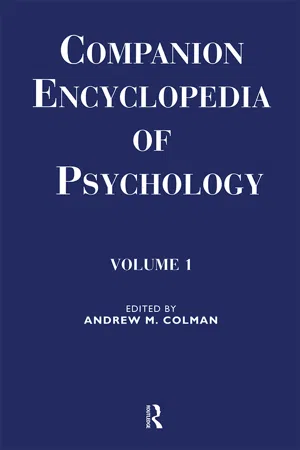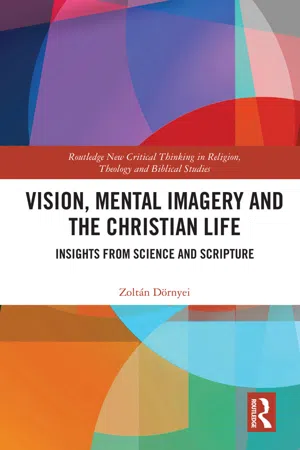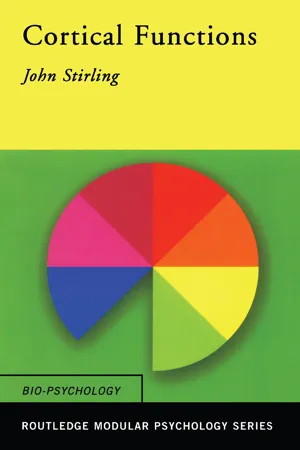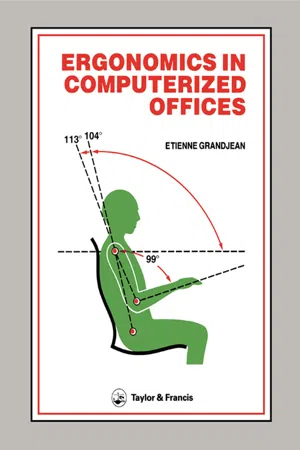Psychology
Vision Psychology
Vision psychology is the study of how the brain processes and interprets visual information. It encompasses the mechanisms of visual perception, including how the eyes and brain work together to create our visual experience. Researchers in this field investigate topics such as depth perception, color vision, visual illusions, and the impact of visual impairments on psychological well-being.
Written by Perlego with AI-assistance
Related key terms
Related key terms
1 of 4
Related key terms
1 of 3
5 Key excerpts on "Vision Psychology"
- eBook - ePub
Companion Encyclopedia of Psychology
Volume One
- Andrew M. Colman(Author)
- 2018(Publication Date)
- Routledge(Publisher)
3.1 Fundamental Processes in VisionPeter C. Dodwell Queen's University , Ontario, Canada- Nativism and empiricism
- The physiology of the visual system
- The visuaf world: space and object perception
- Perceptual illusions
- Gestalt psychology
- Gibson's perceptual theory
- Perceptual plasticity and learning
- The nature of perceptual learning
- Binocular vision and depth perception
- Conclusion
- Further reading
- References
Reading a book, hearing a familiar song, recognizing a friend's face-all are characteristic acts of perception which occur so effortlessly that we take them for granted. Yet the study of perception is a major field in modern psychology, and one that is full of new and interesting challenges. In order to understand the processes of seeing we have to understand the nature of the physical events that give rise to perception, the physiological processes that record them, and the psychological abilities of the perceiver that make sense of them.Perception is the primary process by means of which we obtain knowledge of the world: it has been estimated that more than 80 per cent of it is accounted for by vision. Certainly the visual system is by far the most thoroughly studied of the senses (conventionally five are recognized: sight, hearing, taste, touch, and smell) and the best understood. Perception is a skill, or set of skills, not simply the passive recording of external stimulation (Gibson, 1966). A perceiving organism is more like a map-reader than a camera. What we so easily accept in perceiving and understanding the world involves complex processes at many levels. Psychological research on seeing extends all the way from the study of the electrical activity of single cells in the eye or brain, to colour vision, the perception of objects and events, learning to read, and understanding the complexity of an air traffic controller's video console. - eBook - ePub
Handbook of Visual Communication
Theory, Methods, and Media
- Sheree Josephson, James Kelly, Ken Smith(Authors)
- 2020(Publication Date)
- Routledge(Publisher)
If we are sighted, most of the information we receive comes through our eyes, and the process is a complex one, indeed—primarily because it is not the eyes that see. It is the brain. In fact, more than half the brain is taken up by visual processing, and at least 30 different areas are specialized to perceive things like motion and color. Neuroscience, concerned with the interaction of neurons with each other and within systems, is therefore an essential primary source to understand how vision works.A significant addition to social science research, “perception theory” can be defined as the application of cognitive neuroscience principles to understanding visual communication: how the brain derives meaning from what it sees, the impact that visual images have on us personally and as a culture, and how visual images can be manipulated to achieve desired outcomes. The mind is still mostly uncharted territory, but every piece of the emerging map has broad implications not only for what it means to “see” but also for what it means to “watch” in a society dominated by visual culture.By addressing how the mind/brain receives information, processes it, derives meaning from it, and uses it, this theoretical approach adds new biomedical information to the study of visual communication and helps us assess the efficacy of existing theories of communication derived from social research. Ultimately, in order to be useful, all communication theory and all assumptions about the way we process images and the impact they have on us must be compatible with neurological research.Simply stated, this perceptual approach to communication theory acknowledges the power and primacy of unconscious emotional processing and particularly targets visual communication as a process dependent on automatic action-based systems of response. In light of current neurological research, for example, we can no longer assume that a person’s response to visual images will be conscious or logical. Rather, neurological research reveals that visuals may be processed and form the basis for future action without passing through consciousness at all. Developmentally, too, we know that children and teenagers reason primarily through their emotions as the frontal lobes of the brain are developing, and are therefore highly susceptible to the influence of norms of behavior absorbed subconsciously through visuals in the way they think and act. The recognition of the existence of a mirror neuron system (MNS) also lends insight into why we imitate what we see, both mindfully and mindlessly. Every aspect of perception, therefore, has profound implications for all areas of communication, and none more than visual communication. Ultimately, the key to understanding all visual communication lies in the neurological workings of the brain. We must therefore begin here. - eBook - ePub
Vision, Mental Imagery and the Christian Life
Insights from Science and Scripture
- Zoltán Dörnyei(Author)
- 2019(Publication Date)
- Routledge(Publisher)
examining how children fantasise and make plans) and cognitive psychology (e.g. studying how people deploy mental resources to manage vision-related tasks) to personality and social psychology (e.g. exploring how people’s envisioning of themselves in the future can guide their self-concepts and actions), and last but not least, clinical psychology (e.g. helping clients to rehearse coping skills in their minds in order to manage potentially problematic future situations). If we add to this spectrum the interest in the neural processes underlying mental imagery in cognitive neuroscience as well as the copious applications of visualisation in the worlds of sports and business, we may agree with Taylor and her colleagues that the capacity to generate, behold and manipulate visions of the future is indeed a most impressive and intriguing human skill, linked to a wide range of possible research perspectives and applications. 57 Taylor et al., “Harnessing the Imagination,” 429. The different approaches to understanding how vision is related to motivated behaviour have produced a range of theoretical explanations. From these it appears that the motivational capacity of vision can be explained by the fact that it can trigger off a number of different mechanisms. This ensures that most people will be positively affected by at least some of the activated processes – to put it broadly, vision can stir up something in virtually everybody - eBook - ePub
- John Stirling(Author)
- 2020(Publication Date)
- Routledge(Publisher)
7 Visual mechanisms and perception Introduction Sensation and perception Sensory processing: from eye to brain Colour vision Perceptual processes Object recognition: the WHAT stream and agnosia Spatial functions and the WHERE stream Specific disorders of spatial processing Evaluation of spatial perception and the WHERE stream Summary Introduction Of all the senses, vision, in the view of many people, is the most remarkable. Think for a minute of the processing that is required as you read this page. The lines and angles of print reflect light into your eyes. The light excites cells in the retina, which send nerve impulses deep into the brain. From here, the ‘neural messages’ undergo several further stages of processing. There are separate cortical regions to deal with colour and movement, and additional regions to coordinate reading, object recognition and probably facial recognition too. Yet if you close your eyes for a moment, turn round a few times, then open them again, your view of the world is, to all intents and purposes, instantaneous and effortless! Sensation and perception To simplify matters, I will distinguish between the sensory mechanisms of vision, and the perceptual processes which permit recognition of the visual input. ‘Visual sensation’ is about input ‘getting registered’ in the brain. Perception is concerned with the interpretation of the stimulus. To understand the former we need to know a little about the structure of the eye, and the route that visual input takes from the retina to the occipital cortex. To understand the latter (or perhaps begin to understand, since so much more is yet to be learned by psychologists), we will consider some research findings from case studies of people who have lost certain perceptual functions, usually after damage or disease to key cortical regions - eBook - ePub
- E. Grandjean(Author)
- 1986(Publication Date)
- CRC Press(Publisher)
4. Vision
4.1. The visual system
Visual perception
The eyes, acting as receptor organs, pick up energy from the outside world in the form of light waves and convert these into a form of energy that is meaningful to a living organism, i.e., into bioelectric nerve impulses. It is only through the integration of sensory impulses by the brain that we have visual perception. If the afferent sensory nerves, linking the eyes with the brain, are cut, we become blind. Perception in itself does not give a precise photocopy of the world outside: our impressions are a subjective modification of what is perceived. Thus:A particular colour seems darker when it is seen against a bright background than when it is seen against a darker background. A straight line appears distorted against a background of curved or radiating lines. A steady sensation over a long period becomes gradually weaker and can finally vanish. People differ in the intensity with which they react to visual information: an image can leave one subject indifferent while it may create great emotion in another subject.Control mechanisms
The successive stages of seeing can be simplified as follows: light rays from an object pass through the pupil aperture and converge on the retina. Here the light energy is converted into the bioelectric energy of a nerve stimulus which then passes as a nervous impulse along the fibres of the optic nerve to the brain. At a first series of intermediate nerve cells—called neurons—new impulses are generated which branch off to the centres which control the eyes, regulating the width of the pupils, the curvature of the lens and the movements of the eyeball. These control mechanisms keep the eyes continuously directed at the object, and this is automatic, i.e., not under conscious control. At the same time the original sensory impulses travel further into the brain, and after various filtering processes end up in the cerebral cortex, the seat of consciousness. Here all the signals coming from the eye are integrated into a picture of the external world. Here, too, arise new impulses which are responsible for coherent thought, decisions, feelings and reactions. These processes of the visual system are shown diagrammatically in Figure 8
Index pages curate the most relevant extracts from our library of academic textbooks. They’ve been created using an in-house natural language model (NLM), each adding context and meaning to key research topics.
Explore more topic indexes
Explore more topic indexes
1 of 6
Explore more topic indexes
1 of 4




